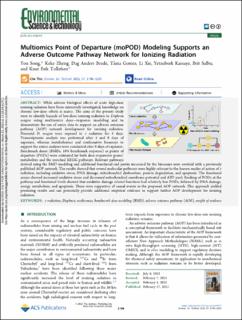Multiomics Point of Departure (moPOD) Modeling Supports an Adverse Outcome Pathway Network for Ionizing Radiation
Song, You; Zheng, Keke; Brede, Dag Anders; Gomes, Tania; Xie, Li; Kassaye, Yetneberk Ayalew; Salbu, Brit; Tollefsen, Knut-Erik
Peer reviewed, Journal article
Published version
Permanent lenke
https://hdl.handle.net/11250/3060178Utgivelsesdato
2023Metadata
Vis full innførselSamlinger
- Publikasjoner fra Cristin - NIVA [2149]
- Scientific publications [1172]
Originalversjon
Environmental Science & Technology. 2023, 57 (8), 3198-3205. 10.1021/acs.est.2c04917Sammendrag
While adverse biological effects of acute high-dose ionizing radiation have been extensively investigated, knowledge on chronic low-dose effects is scarce. The aims of the present study were to identify hazards of low-dose ionizing radiation to Daphnia magna using multiomics dose–response modeling and to demonstrate the use of omics data to support an adverse outcome pathway (AOP) network development for ionizing radiation. Neonatal D. magna were exposed to γ radiation for 8 days. Transcriptomic analysis was performed after 4 and 8 days of exposure, whereas metabolomics and confirmative bioassays to support the omics analyses were conducted after 8 days of exposure. Benchmark doses (BMDs, 10% benchmark response) as points of departure (PODs) were estimated for both dose-responsive genes/metabolites and the enriched KEGG pathways. Relevant pathways derived using the BMD modeling and additional functional end points measured by the bioassays were overlaid with a previously published AOP network. The results showed that several molecular pathways were highly relevant to the known modes of action of γ radiation, including oxidative stress, DNA damage, mitochondrial dysfunction, protein degradation, and apoptosis. The functional assays showed increased oxidative stress and decreased mitochondrial membrane potential and ATP pool. Ranking of PODs at the pathway and functional levels showed that oxidative damage related functions had relatively low PODs, followed by DNA damage, energy metabolism, and apoptosis. These were supportive of causal events in the proposed AOP network. This approach yielded promising results and can potentially provide additional empirical evidence to support further AOP development for ionizing radiation.

